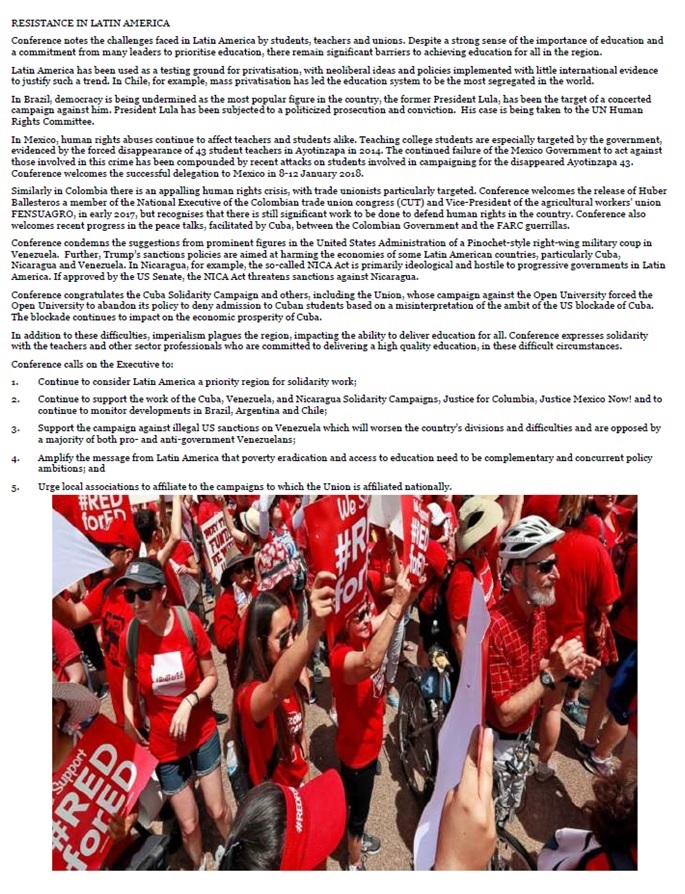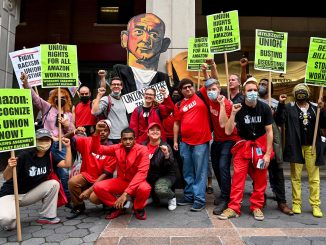Lots of young, rebellious, angry teachers, consciously unaligned with any of the Left organisations, are determined to fight back this year, and to make the next National Union of Teachers conference a real battle.
by Thomas Fagan
The anger behind the wave of teachers’ strikes spreading across the US has unfortunately not been duplicated at the teacher-union conferences in the UK, even though the issues of low pay, long hours, school cuts and mind-numbing curriculum are the same.
The biggest education union in Europe, the National Union of Teachers (NUT), had its annual conference in Brighton, England at Easter. NUT recently amalgamated with the Association of Teachers and Lecturers (ATL) to create a “super union,” the National Education Union (NEU).
The conference passed a motion on pay, committing the union to ballot for national action on a 5% pay rise, a limit on teacher working hours and an end to performance-related pay. That’s good news. But the union leadership is a past master of diverting teachers’ anger and conference resolutions into harmless channels of “hacktivism”—endless rounds of “doing stuff”, like setting up stalls, sending postcards, holding public meetings etc. These activities look meaningful, but are actually designed to tire out union activists and discourage real action.
The avoidance of national strike action is like a carefully choreographed dance. The conference commits to taking strike action. The union leadership knows this is going to happen and tells the rank and file of the union that they are right behind the members. The leadership sighs that they need to see proof that there is a real mood for action before they can sanction a strike ballot. They organise events which are carefully managed and controlled by the leadership to give a semblance of organising a fightback. For full-time teachers working 60- and 70-hour weeks, another round of weekend leafletting without any strike action in sight is exhausting and meaningless. Yet this kind of activity is cynically designed to get Union leaders disguise their own inertia and lack of strategy.
UK teachers' union passes resolutions on Latin America, while teachers throughout the US go on strike.
There is, however, a significant difference between the US and the UK in terms of how tough it is to take strike action.
In the UK, the draconian Trade Union Act of 2016 makes it difficult to take national strike action, irrespective of who is leading the union. In order for a ballot for strike action to be legal, 50% of members must turn out to vote, and a simple majority must be in favour of action. So if 100 members are balloted, at least 50 must vote. In addition, at least 40% of those balloted have to have voted for strike action. Any strike ballot must conducted by post, which historically reduces turnout. Turnout in the last NUT strike ballot in 2016 was around 24%, even though 91% of those voting wanted strike action.
The Communication Workers Union (CWU) defied this trend in 2017 and smashed the 50% threshold, although their leadership later did a deal with the employer, Royal Mail. The problem with teachers achieving a successful strike ballot is that the workforce is widely dispersed into many small locations and the NUT/NEU is a much bigger union than the CWU. Also the low turnout in 2016 gave the Union leadership the excuse to say that they will not sanction another national ballot unless they can be guaranteed double the previous turnout.
In the past, the NUT leadership have generally conducted single days of strike action, or two at most––after which they give up. This policy has fed apathy and resulted in low turnouts. Members’ are apprehensive that, by voting to strike, they would be giving up a day’s pay for almost no end product. They want to see more action, or at least a sustained strike strategy.
To make any impact, sustained action is needed, as the Government can easily ride out bad headlines for a single day. But because teachers have been stung with false promises of sustained action on a number of occasions, they are openly cynical about another token single-strike day. The size of the union, the postal nature of voting and the very high turnout threshold are other barriers to winning a legal ballot to strike, and they have been gleefully seized upon by union leaders who openly admit that there is no prospect of meeting this target.
In the next period, there will be a series of battles within the union to get it to commit to balloting for action. The main arena of struggle for the union leadership seems to be on Twitter, where union members are invited to tweet their pleasure or displeasure at various political pronouncements from the Education Secretary. The Union likes to create “twitterstorms”.
Trade-union leaders in general have their own mechanisms to control the membership. The NEU leadership like to use social media like Twitter, not just to attack education policy, but as a mechanism to control members. Social media have their uses. Persuading members to go online at a certain time to harangue an Education Minister is not necessarily a negative tactic. But in this context, its use is always sanctioned at the top. When members use social media in a way that the leadership do not like, they are reminded who is in charge. For example, the NEU Facebook page, which is an unofficial group whose administrators are friendly to the leadership, has been informed in no uncertain terms by the NEU leadership, that it does not reflect union policy. In response, the rather tame Facebook group sarcastically renamed itself “Members’ Mega Group––For members by members”. Other NEU members, who have been very pro-active in lobbying and emailing Labour Party councillors that have actively implemented anti-union policies, have been told by Regional officials that they are being unhelpful for doing so. In many respects therefore, even in terms of social media, unions are one of the most controlling of institutions.
Even quite straightforward action, such as the union taking on employers in the courts, is a non-starter. A NUT conference resolution calling for a robust approach to teacher workload, using the courts to enforce working time limits––an easily achievable measure––was kicked into the long grass as the conference conveniently ran out of time on the last day to discuss vital matters about terms and conditions. Instead, a series of long-winded speakers and tedious videos punctuated the conference agenda and prevented teacher delegates from doing what teacher delegates gave up 5 days of their holidays to do––discuss the crushing effects of workload and low pay on teachers. Motions to the conference that complain about how bad things are, without committing the union to actually do something, are fine; but they take up vast amounts of time. Motions about “resistance in Latin America” were discussed, but how about a bit of resistance in the UK? In fact, the references to South America were confined largely to the neo-Stalinists’ favourite countries, the “Socialist paradises” of Cuba and Venezuela, and were not meaningful in terms of international solidarity.
The conference finished on an angry, yet optimistic, note. The last motion to be discussed at the conference was the situation of Supply Teachers (called “substitute teachers” in the US). These teachers are super-exploited and super-ignored. Just as the vote was about to be taken, which would have resulted in a defeat for the union leadership, the President ruled that we were out of time. And then the leadership put on a 15-minute video for delegates to watch––a video that we could have all seen on YouTube on the way home. This was widely regarded as an insult to conference delegates. After the conference, we spoke to lots of young, rebellious, angry teachers, consciously unaligned with any of the Left organisations, who were determined to fight back this year, and to make the next conference a real battle.

 UK teachers' union passes resolutions on Latin America, while teachers throughout the US go on strike.
UK teachers' union passes resolutions on Latin America, while teachers throughout the US go on strike.

Be the first to comment